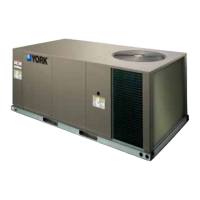
Do you have a question about the York International XN SERIES and is the answer not in the manual?
| Brand | York International |
|---|---|
| Model | XN SERIES |
| Category | Heat Pump |
| Language | English |
Read and follow safety instructions before installing the unit.
Units must comply with NEC, local codes, and utility requirements.
Inspect unit for damage during transit upon receipt.
Lists additional resources for information.
Design certification by CSA for specific installation types.
Read and follow safety instructions before installing the unit.
Units must be installed per codes and requirements.
Guidelines for selecting a suitable location for unit installation.
Critical clearances required for service and operation.
Procedures for safely moving and lifting the unit.
Physical specifications for unit placement and support.
Weight details for optional unit accessories.
Guidelines for designing and installing ductwork systems.
Proper plumbing of the condensate drain line.
Information on the scroll compressors and their requirements.
Filter types, installation, and maintenance.
Field wiring requirements for power and control circuits.
Wiring guidelines for connecting the thermostat.
How the IAQ sensor connects and affects unit operation.
Proper electrical phasing for compressor and motor rotation.
Checking and correcting blower rotation direction.
Instructions for assembling economizer rain hood.
Instructions for power exhaust/relief damper installation.
Functions driving the economizer operation.
Setting economizer minimum position for occupied mode.
Available free cooling options and their operation.
Free cooling based on dry bulb temperature.
Free cooling based on single enthalpy.
Free cooling based on dual enthalpy.
Automatic free cooling type determination.
How the unit operates during free cooling.
Adjustable settings for power exhaust control.
Inputs used by the power exhaust control.
Outputs controlled by the power exhaust system.
How the power exhaust system functions.
Description of analog and digital terminals on the economizer board.
Factors for adjusting performance based on altitude and temperature.
Procedures for selecting blower drive and motor.
Example illustrating blower performance data interpretation.
Table for selecting motor sheave setting and RPM.
Specifications for belt drive indoor blowers.
Steps to measure CFM using pressure drop across the coil.
Figure illustrating pressure drop vs. CFM for unit selection.
General sequence of heating and cooling operations.
Operation of the blower when set to continuous mode.
Operation of the blower in AUTO mode with delays.
Unit operation without outdoor air control features.
Economizer operation with single enthalpy sensing.
Economizer operation using dual enthalpy sensors.
Operation of economizer with power exhaust system.
Operation of units with motorized outdoor air dampers.
Action taken when high-pressure limit opens.
Action taken when low-pressure limit opens.
Action taken when evaporator low limit sensor triggers.
Unit operation in low ambient temperature conditions.
How to reset cooling error messages and restore operation.
Heating operation with or without auxiliary electric heat.
Conditions for initiating a defrost cycle.
Conditions for ending a defrost cycle.
Time interval requirements between defrost cycles.
Automatic defrost cycle initiation.
Table for electric heat limit switch settings.
Table for electric heat anticipator settings.
Checks to perform before starting the unit.
Steps to follow for unit operation after start-up.
Checks to perform after initial unit operation.
Accessing control points using LCD or MAP Gateway.
Diagram and details of the UCB and its terminals.
General maintenance tasks for the unit components.
Inspecting and replacing air filters for optimal airflow.
Maintenance for outdoor and indoor blower motors.
Cleaning the outdoor coil for efficient heat transfer.
Checklist items for general unit inspection.
Checklist for inspecting air movement components.
Checklist for powered and barometric relief exhaust.
Checklist for economizer functionality and settings.
Recording electrical data for unit components during operation.
Checks for refrigerant system safety and proper operation.
